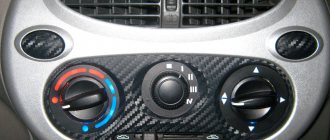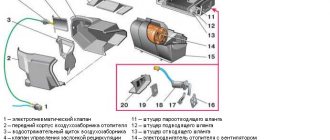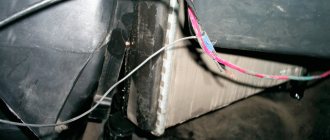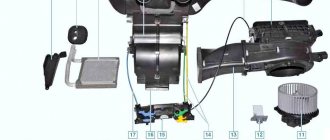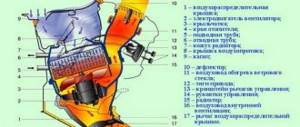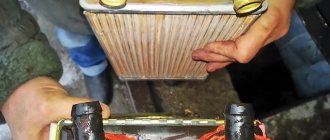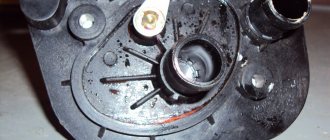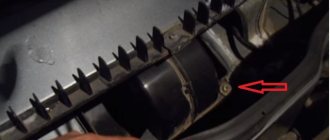Today I finally finished my plan! and so, I bought: -gazelle stove tap -classic stove pipes -clamps -window lifter button
CONNECTION: the electric valve itself: - black wire - minus - - red wire - plus + - white wire - button chip No. 7 - brown wire - button chip No. 1
the button itself: -No. 7 and No. 1, we already know where))) -No. 2 — minus- (ground) - No. 5 — minus- (ground) - No. 4 — button illumination, to the tidy dimensions (plus+) - No. We cut 3 and No. 6 with pliers, they are not needed)
I took off the stove, blew out a bunch of leaves (as is usually the case), threw out the original faucet, put a short pipe in its place, connected a hose, put everything back in place, installed a new faucet under the hood and connected it, stuck a button in the beard, connected everything to the heap, and Oh miracle! works!) Only positive emotions! Now, in order to warm up or, on the contrary, turn off the stove, just a light touch of your finger to the button is enough! it's a thrill) now if the tap leaks, it will leak into the street, and not into the salon) I recommend it to everyone! Thanks to all)
Each car has a cabin heating system connected to the engine cooling system. Electric heater taps are widely used today to control the stove - read about these devices, their types, design, principle of operation, as well as their selection and replacement in this article.
What is an electric heater valve?
Electric heater valve (heater control valve with electric drive, heater valve) is a component of the vehicle interior/cabin heating system; a tap or valve to control the supply of coolant from the engine cooling system to the heater radiator (heat exchanger).
An electrically operated faucet is similar to a mechanical faucet, but is driven by a built-in electric motor or solenoid. This solution made it possible to abandon the cable drive and implement control of the heater using a button. Electric cranes make it possible to implement various schemes for heating the interior and operating the engine cooling system, while they are easy to use, reliable in operation and have a simple design.
Types, design and operating principle of electric heater valve
Electrically controlled faucets existing today are divided into groups according to the type of shut-off element and its drive, and according to the number of circuits (and, accordingly, pipes).
Based on the number of circuits and pipes, heater valves are:
- Single-circuit / 2-pipe - ordinary taps / valves;
- Double-circuit / 3-pipe - three-way valves.
Double-port valves are valves that can only open and close the flow of liquid. In such a faucet, one pipe is inlet, the second is outlet, and between them there is a shut-off element. The dual-port heater valve is used in conventional interior heating systems and is located between the engine cooling system outlet and the heater core inlet to control the flow of hot coolant.
Three-way valves are three-way valves that can direct fluid flow into two different pipelines. This faucet has one inlet and two outlets, and the shut-off element is designed in such a way that it can direct liquid from the inlet to one of the outlets while simultaneously blocking the other. A heater valve with three pipes can be used in various interior heating systems: with bypass, with an additional heater, etc.
According to the type of shut-off element and its drive, taps are:
- Gate valves driven by an electric motor;
- Shut-off valves driven by a solenoid.
The design of gate valves is simple. They are based on a plastic molded body with pipes, inside of which there is a rotating plate in the form of a solid sector or a sector with holes the size of the pipes. A compact electric motor with a simple gear reducer is installed on the housing, with the help of which the plate rotates. In faucets with two nozzles (double-circuit), both nozzles are located opposite each other, with a plate between them. Three-way faucets have an inlet on one side and two outlets on the other.
The heater valve with an electric motor works as follows. When the heater is turned off, the valve plate is located between the pipes, blocking the flow of liquid - in this case, hot liquid does not flow into the heater radiator, and the interior heating system does not work. If it is necessary to turn on the stove, the driver presses a button on the dashboard, current is supplied to the electric motor of the faucet, it turns the plate and opens the path of coolant - the heater radiator heats up, the interior heating system begins to work. To turn off the heater, the driver presses the button again, all processes occur in reverse order, and the heater turns off.
Varieties
Depending on the shut-off element used, the drive and the number of circuits, there are two types of electrically controlled valves. Moreover, both options can be used on Gazelle cars.
Depending on the number of circuits and the number of pipes, devices are divided into the following categories:
- single-circuit or double-pipe;
- double-circuit or three-pipe.
In the first case, this is a regular tap that only opens or closes the flow of liquid in the system. Two-pipe devices provide for one inlet and one outlet pipe, between which there is a shut-off element. Typically, such taps are used in the interior heating system. They are mounted between the outlet (pipe) of the internal combustion engine cooling system and the inlet on the heater radiator. This allows the driver to control the flow of hot coolant.
The second option is a three-way valve. It is capable of redirecting fluid flows into two pipelines. It uses one inlet pipe and two outlet pipes at once. The shut-off element is made in such a way as to direct the coolant flow into one exhaust pipe, while simultaneously blocking the second. It has found quite wide application in interior heating systems of cars, including Gazelle.
Depending on the shut-off element and the drive, the stove taps are divided into gate valves with an electric motor and shut-off valves with a solenoid drive.
Gate models are structurally quite simple. They are made in the form of a molded plastic case with pipes. There is a rotating plate inside. On the body there is a small electric motor with a gear reducer, which ensures the rotation of the plate.
Models with electric drive work slightly differently. When the stove in the Gazelle is turned off, a plate inside the tap is located between the nozzles, shutting off the flow of liquid. This prevents hot coolant from entering the stove radiator. Thus, the heating in the cabin stops working. If you need to turn on the stove, the driver presses a special button on the Gazelle panel, and the electric motor receives current, turns the plate and allows the liquid to pass through the radiator. To turn off the heating in the Gazelle, just press the button again, and the process will begin to occur in reverse order.
The situation with solenoid valves is different. They are also made of a plastic body, but inside there is a cone-shaped lift gate. When closed, this valve is located on its seat, thereby blocking the flow of hot cooling liquid. The shutter is connected through a rod to the solenoid armature mounted on the body of the electric crane. If no voltage is applied to the solenoid, the channel is in the open position. When starting the engine, the solenoid receives a charge and the valve closes. When you turn on the stove, the solenoid is de-energized, thereby opening the valve and hot liquid flows to the radiator. When turning off the stove, a displacement occurs through the voltage on the solenoid, and the electric valve closes.
Modern furnace equipment on most domestic and foreign cars has switched to the use of electric cranes. They have almost completely replaced the old mechanical devices. These are expected changes, since the current controls on the Gazelle are more convenient and functional.
Questions about choosing and replacing a heater tap
The heater valve is very important for the operation of the interior/cabin heating system, however, selecting and replacing this part in most cases does not cause any problems. To select the right faucet, you must follow several recommendations:
- The power supply voltage of the crane motor must correspond to the voltage of the vehicle’s on-board electrical network - 12 or 24 V;
- The type of tap - 2 or 3 pipes - must correspond to the interior heating system diagram. For conventional systems, a tap with two pipes is required; for systems with bypass, a tap with three pipes is required. Also, a tap with three pipes can be used to create a heating system with an additional heater;
- The diameter of the pipes must correspond to the diameter of the heating system pipelines, but if necessary, adapters can be used;
- The faucet and vehicle must have the same type of electrical connector. If necessary, it is necessary to replace the type of connector on the vehicle;
- The crane must have dimensions suitable for its installation.
The heater valve must be replaced after draining the coolant; metal clamps must be used for installation. It is necessary to ensure that the tap is installed correctly - position its inlet and outlet pipes in accordance with the direction of the liquid. For convenience, there are arrows on the nozzles indicating the direction of fluid flow. If you install a regular 2-pipe valve incorrectly, the system will work, but incorrectly installing a 3-pipe valve will make the system completely inoperable. If the faucet is installed correctly and reliably, the stove will start working immediately, providing warmth and comfort in the car interior.
Fault identification
An electronic regulator is located on the heater body, due to which it is possible to smoothly adjust the fan speed. There is also a problem with access to it, as well as to other elements of the unit. The only thing you can get to without disassembling a significant part of the system is the heater core. To do this, simply remove the glove compartment. What to do if the stove does not work in the GAZelle Business system? Indeed, due to the lack of full access, the ability to diagnose equipment is lost. In such cases, the first thing to check is the fuse. To check the functionality of the gear motor that controls the windshield defrost flaps, there is no need to remove the entire panel - its lower part on the driver's side is removed. To diagnose it, a voltmeter or test lamp is connected to the connectors with the electric motor and the clamp. We activate the damper with the corresponding button in the ignition on mode. If the lamp is on and the gearmotor shows no signs of life, it means it must be replaced. How to remove the faucet of a GAZelle Business stove (like the electric heater itself) cannot be described in words, but with the help of a diagram you can familiarize yourself with its structure and figure out what’s what.
Read more: What kind of tips for the UAZ Patriot
If it is not possible to replace the damper actuator, then on the driver's side you can remove the rod from the damper lever by manually turning it to the open position. To do this on the passenger side, you will need to first unscrew the screws securing the gearmotor and fix it in the same way by turning the housing. In order to diagnose the fan motor and determine the causes of its failure, it will be necessary to remove the air intake, which is located under the hood. This will need to be done if the fan does not work. After dismantling the air intake, the connectors of two wires will become visible. Having connected a test lamp to these connectors, you must turn on the ignition, and the lamp should light up brightly. As the speed is adjusted downward, the brightness of the lamp should decrease. This is precisely an indicator of the serviceability of the speed controller. If the lamp is on, but the fan does not function, the problem is in its electric motor. Problems with the electric motor may be caused by stuck brushes. In such a situation, you can try to knock on the heater unit. The fan may resume its operation for a short time, and this will be enough at least to get to the service without freezing. If during the test it becomes clear that the speed controller has failed, the positive wire can be transferred to the fused connector next to the battery. This will also be a temporary solution to a problem that arises on the road when it’s cold outside. Also below is a diagram of the GAZelle heater valve.
Design of the cooling system for UMZ-4213 and UMZ-4216 engines on UAZ and GAZelle vehicles.
To increase energy performance, improve fuel efficiency, reduce toxicity and noise, models with an integrated microprocessor fuel injection and ignition control system were developed on the basis of the UMZ-421 carburetor engine: the UMZ-4213 engine for UAZ cars and the UMZ-4216 engine for GAZelle cars. The design of the cooling system on the UMZ-4213 and UMZ-4216 is somewhat different, since it has differences in the connection diagram of the expansion tanks and heating radiators.
Gazelle stove diagram
How the stove works in Gazelle Business
For correct diagnostics and repairs, it is necessary to know the structure and operating principle of the heater in order to diagnose a breakdown or carry out repairs at the first sign of a malfunction, preventing failure of the entire unit as a whole. Most faults can be predicted by indirect signs and their progression can be prevented. To do this, you need to know and understand what each element is responsible for and what the principle of its operation is.
Car cooling system
In Gazelle Business the stove is an integral part of the engine cooling system. When the engine operates, a large amount of heat is generated that must be removed. Heat is released due to fuel combustion and from rubbing surfaces. If the heat is not removed, the engine will heat up very quickly and fail. The cooling system has two circuits (small and large circle), they are separated by a thermostat. When the liquid is cold, it circulates in a small circle, and when it warms up, it circulates in a large circle. This allows you to quickly reach operating temperature and not overheat. During the warm season, heat is released into the atmosphere, and when cold weather sets in, part of the heat is spent on heating the cabin.
System modernization
The main problem that causes electronics to fail is moisture. And in the tap the liquid circulates constantly, even when the shutter is closed. And when the oil seal leaks, liquid floods the entire electrical part, and it fails.
Installation of shut-off valves
To avoid this, you can install conventional shut-off valves, fitting them to the outlets of the cooling system. But in order to open or close the supply of hot liquid, you need to move the tap to the desired position manually. And since it is installed under the hood (in a regular place), it is not possible to do this while driving. But this mechanism has a much greater resource.
Pre-sealing
Before installing a new electric faucet, you need to disassemble it and fill the electronic board with hot glue to avoid moisture getting on it, coat all joints with sealant. This method can only prolong performance, because if liquid gets into the electronic part, the electric motor will be damaged, without which the mechanism will not be able to function correctly.
Selection of similar equipment
Installation of a tap with a similar arrangement of fittings from other car brands. This method is the most effective, since imported manufacturers of this equipment have a much higher resource than domestic ones. The main thing is to choose the most similar copy. And after installation, check its operation on the car.
The above diagnostic and repair methods will help you quickly identify the cause of the malfunction and replace or repair faulty equipment. Repairing and installing a heater tap on a Gazelle Business UMZ 4216 will not cause you any particular difficulties. This type of repair does not require extensive experience. It can be done on the road with a minimum set of tools.
Drain the coolant. Using a Phillips screwdriver, unscrew the four self-tapping screws securing the document section shelf (see “Removing and disassembling the instrument panel,” p. 312).
. and remove the shelf.
We disconnect the wiring harness connectors for the electric drive of the heater valve.
Use a slotted screwdriver to pry off the rear piston for fastening the heater trim on the right side.
We take out the piston and...
Similarly, remove the front piston with socket.
Move the right side of the heater trim down.
Using the “8” head, loosen the tightening of the hose clamp on the outlet pipe of the heater tap.
Disconnect the valve from the heater radiator hose and lower the valve to a convenient position.
Using the “8” head, loosen the hose clamp on the inlet pipe of the faucet.
Disconnect the heater tap from the hose.
We install the new heater valve in the reverse order and fill the system with coolant.
Let's start the engine. Turn on the heater and make sure there are no coolant leaks at the connections. If necessary, tighten the hose clamps.
Each car has a cabin heating system connected to the engine cooling system. Electric heater taps are widely used today to control the stove - read about these devices, their types, design, principle of operation, as well as their selection and replacement in this article.
